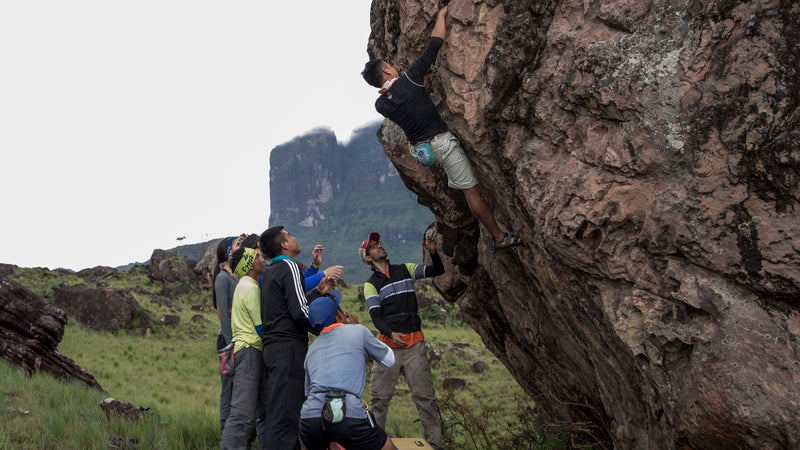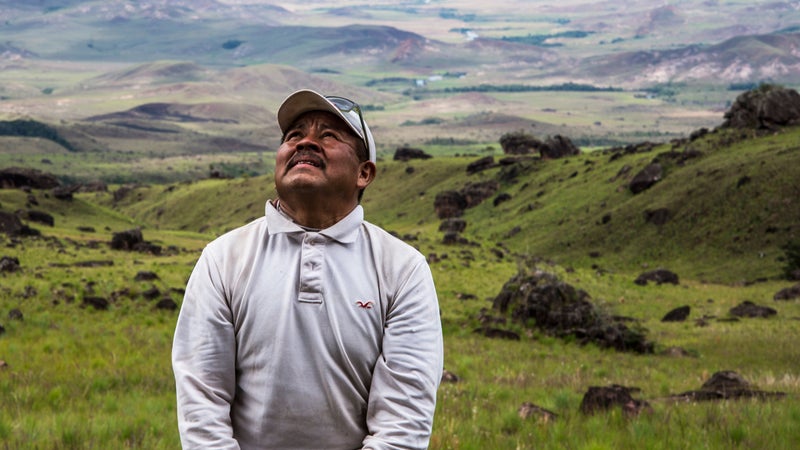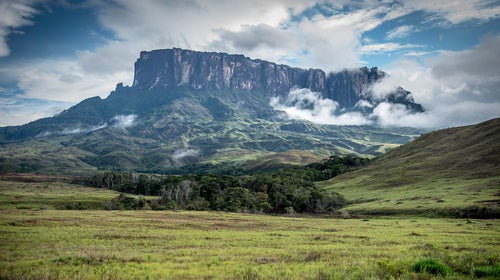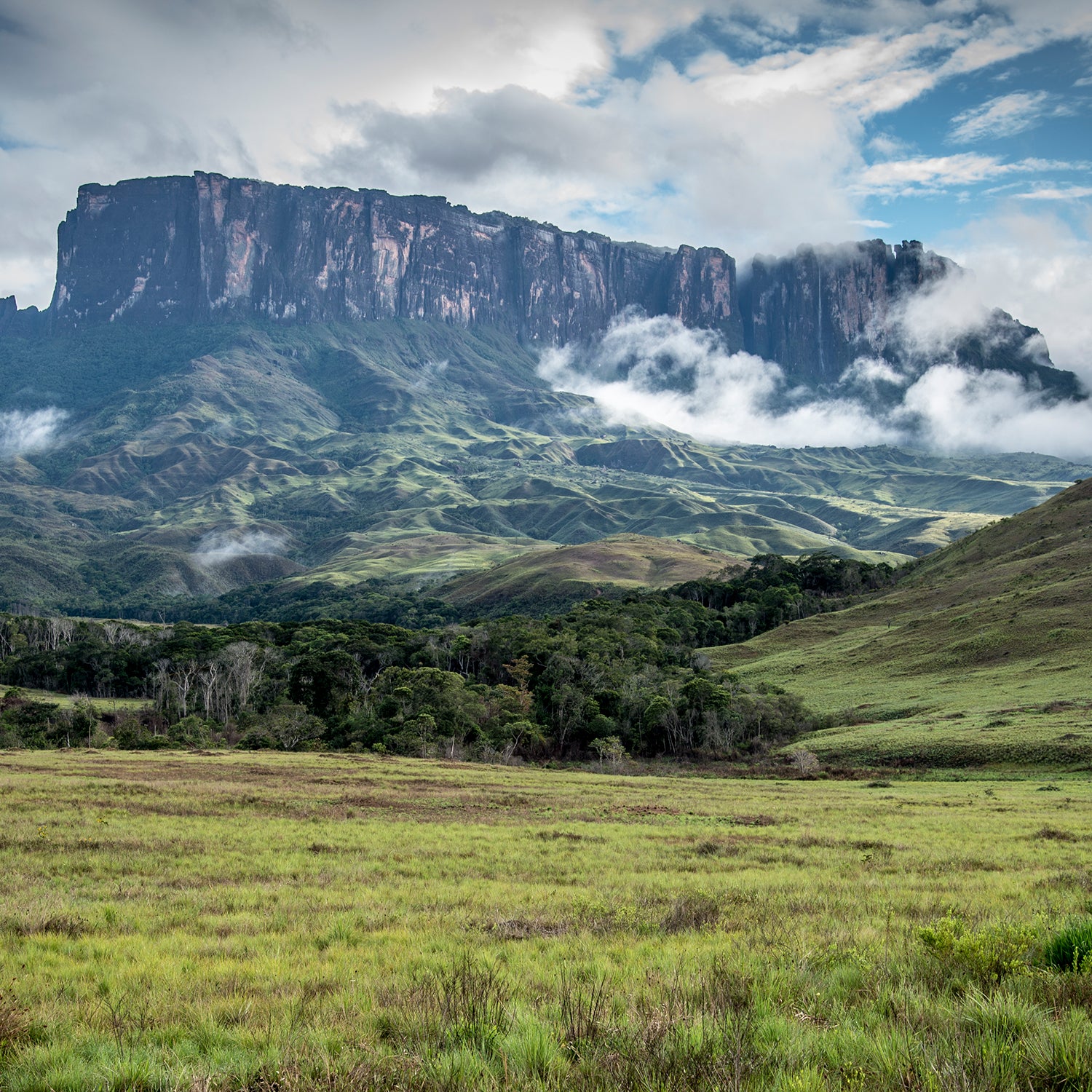Rolando Garcia led his first group of trekkers to the top of 9,220-foot Mount Roraima in 1983, while he was still a teenager. He would go on to summit the mountain,��the highest point in Venezuela’s Canaima National Park, at least 250 times during��his career as one of the best guides in the region.
Garcia honed his craft in the time of “the other Venezuela,”��when the country was the wealthiest in Latin America, during the last decades of the 20th��century. The prosperity helped create��a steady stream of adventurous Venezuelans and international tourists to Canaima to see Angel Falls, the world’s highest waterfall, and the ancient landscape that inspired Arthur Conan Doyle’s The Lost World. During that time, the park also attracted��climbers seeking new big-wall routes up��its��giant tabletop mountains, called��tepuis, including Kukenan and Roraima, which have hosted some of the most famous accomplishments of��,��,��.
Straddling the main road that cuts through Canaima to the Brazilian border, and sitting at the base of Roraima, the indigenous Pemón village of Kumaracapay became a key stop for those��coming to the park. It was also home to Garcia and his wife,��Zoraida Rodriguez, who hosted climbers and trekkers in their household.
Many members of Garcia’s community might never get the chance to venture beyond their own corner of the park, but his��career as the country’s most famous guide��gave Garcia the chance to travel throughout Venezuela.
“People who saw Rolando at home in his hammock might think he had never left his village,” says Daniel Mamopulakos, “but this guy has been everywhere.” Mamopulakos, a climber and mountain biker who lives roughly 600 miles northwest of Canaima��in Caracas, first met Garcia in 2002 and became close with him over dozens of backcountry trips.

I met Garcia in April 2018. He was my guide for a two-week expedition in Canaima��with the an organization of Venezuelan rock climbers developing sustainable tourism in the park.��He had a compact build and a quick smile. He wasn’t an obvious athlete until you saw the grace of his movement. Garcia knew every rock from his years guiding��but was no less engaged than I was seeing this landscape for the first time.
While we were together,��Garcia explained how he and his wife helped make Kumaracapay a destination for visitors, their fight to keep tourism in the park alive in the face of political upheaval, and his vision for the future of the park and the Pemón when the country stabilized and visitors returned.
“The Garcia family is famous among people who know the history of trekking in the area,” says Mamopulakos. “They’re one of the few families who have managed to continue in tourism despite our country’s struggles.”
Venezuela’s economy has been in free fall for nearly a decade due to��corruption and crumbling infrastructure under the leadership of Hugo Chávez and his handpicked successor, Nicolás Maduro. Years of crisis also caused a dramatic shift in the economy of Canaima National Park. As tourism dollars declined, the Pemón turned increasingly to work in�� in and around the park. All around Garcia, guides and porters were becoming miners. Once popular destinations were in danger of becoming mining pits.
Despite these changes, Garcia was determined to continue his family’s traditional way of life.��To earn income outside of guiding, he��and his wife opened a store outside their home on the main road through Canaima. They sold empanadas to truck drivers on their way to the Brazilian border and served meals of chicken, rice, and beer to the trekkers and touring mountain bikers that still came to the park. The family made wood carvings, weavings, and other crafts to sell to tourists as well, small mementos of time spent in the family’s home in the shadow of the mountains.
Because his chosen profession was��becoming untenable, Garcia was eager to help the r. The group argues that even a small number of steady jobs in the tourism industry have the potential to create an economic alternative to mining, providing opportunities for indigenous communities while protecting the environment.
In recent years, Garcia was also spending time in the backcountry with members of the��organization. Those expeditions were part of a larger mission to train a new generation of Pemón guides. Garcia was��important to their work—an example to the younger porters that it was once��possible to earn their livelihood in the mountains and could be again.
However, in February of this year, the full force of Venezuela’s most recent��crisis descended on the quiet town.
The current turmoil was touched off in January when opposition leader and president of the National Assembly Juan Guaidó invoked the constitution to declare himself the legitimate president, citing irregularities in Maduro’s��2018 reelection. Recognized by the United States and more than 50 other countries as Venezuela’s rightful leader, Guaidó began coordinating with the U.S., Brazil, and Colombia to provide humanitarian aid for the country’s impoverished citizens. Maduro viewed the arrival of foreign food and medicine as a threat to his regime and sent military forces to block the aid shipments from entering the country. Pemón leaders�� their intention to peacefully intervene in support of the aid, setting the stage for a showdown with Maduro’s government.
Venezuelan government forces entered Kumaracapay in the early hours of February 22, on their way to block the aid at the Brazilian border. Villagers attempted to stop them. It’s unclear whether they set up a physical or human barrier. In a cell-phone video taken that morning, more than a dozen armed soldiers are seen entering the village on foot. A man can be heard addressing them calmly: “If you want to enter, you have to leave your weapons behind.” As the soldiers continue to advance, he pleads with them to “respect the people.” Then the shooting begins.
Zoraida Rodriguez��confronted the soldiers, asking them to leave. She was shot point-blank and died just steps from her doorway. Garcia ran to her aid and was shot in the abdomen. He survived a six-hour transport by car to a hospital in Brazil��but died on March 2 after a week in intensive care.
The couple had five children, ages 10 through 19.��Their eldest daughter witnessed the attack. Her account was relayed to me by Mamopulakos and by another eyewitness interviewed by Foro Penal, a Venezuelan human-rights organization. My attempts to contact Garcia’s daughter were unsuccessful.��

In addition to Garcia and Rodriguez, the attack killed Kliber Pérez, a 24-year-old mountain guide. Eleven others were wounded. Later that day, the assault on protesters continued in the nearby town of Santa Elena de Uairén, at the southern gateway of the park. In total, Foro��Penal����that seven died, more than 40 were wounded, and more than 60 were illegally detained during the attacks on the two villages.
The Bolivar state governor, a member of the ruling Socialist Party,��blamed the Pemón��for the attacks, in an from March, calling��the Kumaracapay residents’��actions��“terrorist acts.”
Many from Garcia’s village have since fled to Brazil in fear of further government reprisal. This exodus includes his five children, who were able to join their father at his bedside before he died. Since contacting��friends of the family��to announce their parent’s��deaths, they’ve��gone deeper into hiding in��Brazil and are out of contact. I tried to reach them multiple times��but was unsuccessful.
In recent months, Venezuela has suffered�� that have brought major cities to the brink of anarchy and made communicating with remote parts of Canaima even more difficult than usual. While there have been no reports of further violence,�� the possibility of a renewed assault on the Pemón as Maduro clings to power.
During my expedition with Garcia, he described a hoped-for future in which the situation in Venezuela stabilizes��and the tourists return. He knew he was getting too old to take rock climbers and other adventurers on some of the more arduous trips into the tepuis. He dreamed of opening a school to teach the next generation of Pemón guides, having witnessed the beginnings of this goal with the Tepui Project’s work and looking on with pride as some of the best climbers in Venezuela taught young Pemón rope skills.
As the crisis in Venezuela continues, Garcia’s��own long-term vision for his people and the future of Canaima itself remain uncertain. But Garcia was a mountain guide. He knew how to navigate uncertainty and the rewards that lay on the other side.


